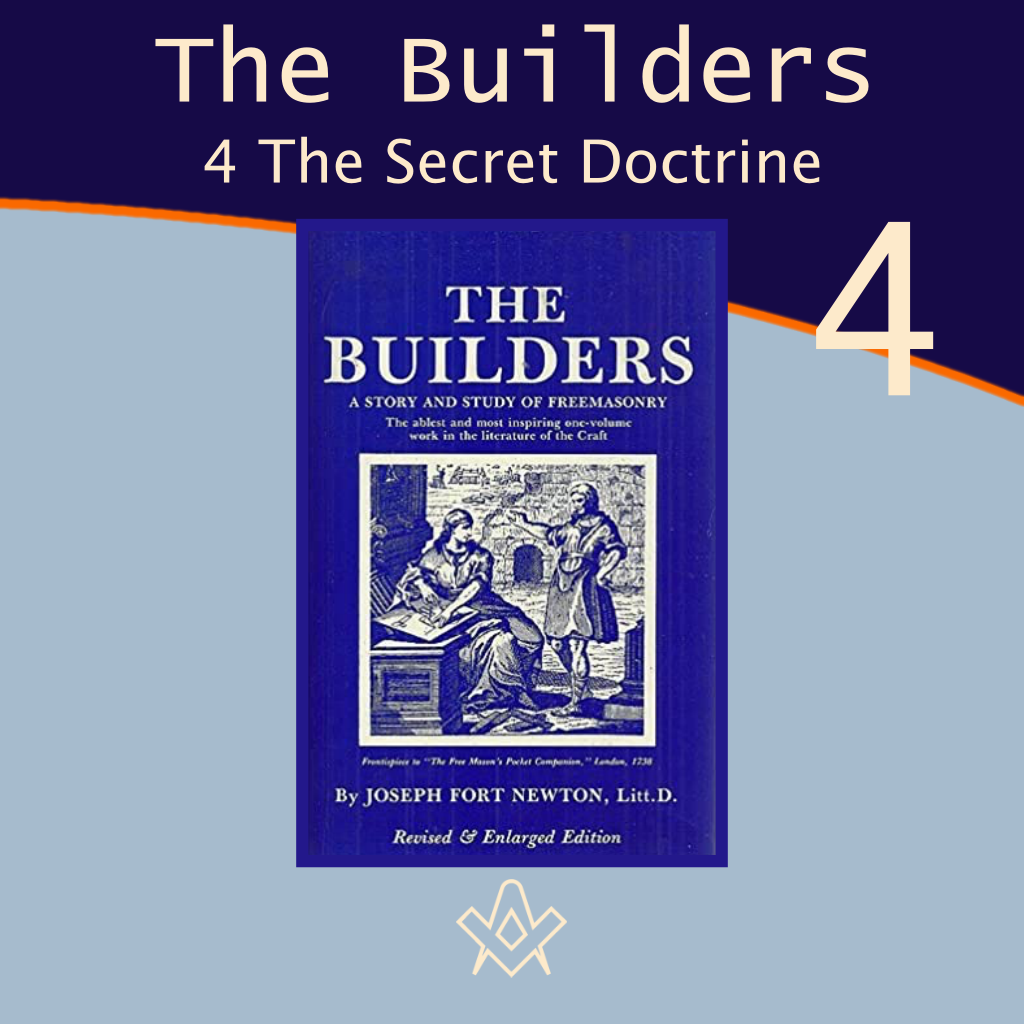In 1915, Joseph Fort Newton’s book, ‘The Builders: A Story and Study of Freemasonry’ was published.
It has become a Masonic classic in as much that it really does lay the foundations of knowledge for us to build upon.
Taking us back to the times of the ‘builders’ before the traditional history of the Craft, he explores not only the history of man’s quest to build – both literally and figuratively – but how it relates to the speculative work of the Freemason.
His insights and wisdom are as relevant today as they were over a hundred years ago.
Extracted from The Builders: A Story and Study of Freemasonry
Joseph Fort Newton
The Torch Press, Iowa, 1915
The value of man does not consist in the truth which he possesses, or means to possess, but in the sincere pain which he hath taken to find it out.
For his powers do not augment by possessing truth, but by investigating it, wherein consists his only perfectibility.
Possession lulls the energy of man, and makes him idle and proud.
If God held in closed in his right hand absolute truth, and in his left only the inward lively impulse toward truth, and if He said to me: Choose! even at the risk of exposing mankind to continual erring, I most humbly would seize His left hand, and say: Father, give! absolute truth belongs to Thee alone.
– G. E. LESSING, Nathan the Wise.
Chapter 4 – The Secret Doctrine
I
GOD ever shields us from premature ideas, said the gracious and wise Emerson; and so does nature. She holds back her secrets until man is fit to be entrusted with them, lest by rashness he destroy himself.
Those who seek find, not because the truth is far off, but because the discipline of the quest makes them ready for the truth, and worthy to receive it.
By a certain sure instinct the great teachers of our race have regarded the highest truth less as a gift bestowed than as a trophy to be won.
Everything must not be told to everybody. Truth is power, and when held by untrue hands it may become a plague.
Even Jesus had His “little flock” to whom He confided much which He kept from the world, or else taught it in parables cryptic and veiled.
One of His sayings in explanation of His method is quoted by Clement of Alexandria in his Homilies: It was not from grudgingness that our Lord gave the charge in a certain Gospel: “My mystery is for Me and the sons of My house.”
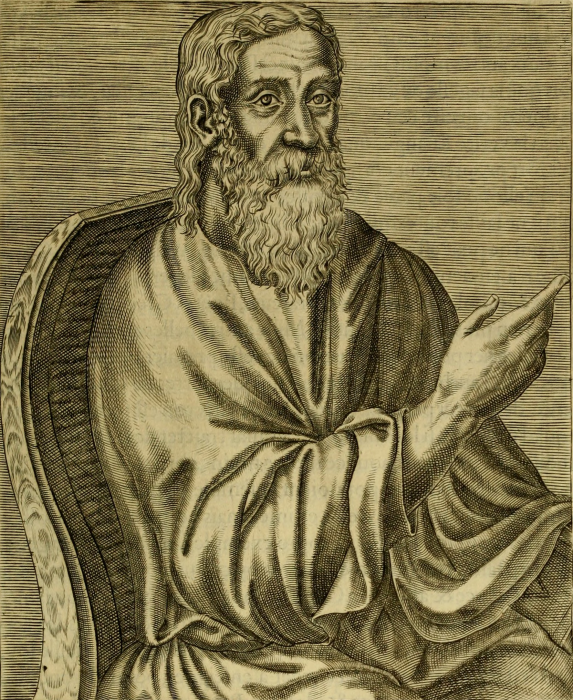
Clement of Alexandria from Les vrais pourtraits et vies des hommes illustres grecz, latins et payens (1584) by Thevet, André, 1502-1590
IMAGE LINKED: wikimedia Attribution 4.0 International (CC BY 4.0)
This more withdrawn teaching, hinted in the saying of the Master, with the arts of spiritual culture employed, has come to be known as the Secret Doctrine, or the Hidden Wisdom.
A persistent tradition affirms that throughout the ages, and in every land, behind the system of faith accepted by the masses an inner and deeper doctrine has been held and taught by those able to grasp it.
This hidden faith has undergone many changes of outward expression, using now one set of symbols and now another, but its central tenets have remained the same; and necessarily so, since the ultimates of thought are ever immutable.
By the same token, those who have eyes to see have no difficulty in penetrating the varying veils of expression and identifying the underlying truths; thus confirming in the arcana of faith what we found to be true in its earliest forms—the oneness of the human mind and the unity of truth.
There are those who resent the suggestion that there is, or can be, secrecy in regard to spiritual truths which, if momentous at all, are of common moment to all.
For this reason Demonax, in the Lucian play, would not be initiated, because, if the Mysteries were bad, he would not keep silent as a warning; and if they were good, he would proclaim them as a duty.
The objection is, however, unsound, as a little thought will reveal. Secrecy in such matters inheres in the nature of the truths themselves, not in any affected superiority of a few elect minds.
Qualification for the knowledge of higher things is, and must always be, a matter of personal fitness.
Other qualification there is none. For those who have that fitness the Secret Doctrine is as clear as sunlight, and for those who have it not the truth would still be secret though shouted from the house-top.
The Grecian Mysteries were certainly secret, yet the fact of their existence was a matter of common knowledge, and there was no more secrecy about their sanctuaries than there is about a cathedral.
Their presence testified to the public that a deeper than the popular faith did exist, but the right to admission into them depended upon the whole-hearted wish of the aspirant, and his willingness to fit himself to know the truth.
The old maxim applies here, that when the pupil is ready the teacher is found waiting, and he passes on to know a truth hitherto hidden because he lacked either the aptitude or the desire.
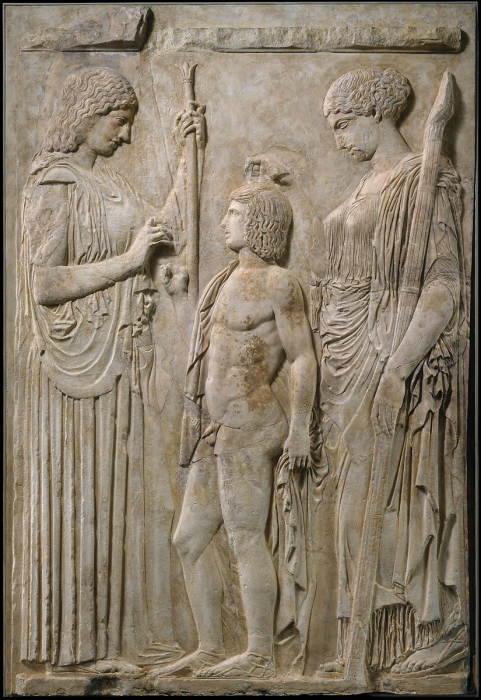
Part of a marble relief found at the sanctuary of Demeter at Eleusis, the site of the Eleusinian mysteries ca. 27 B.C.–A.D. 14.
IMAGE LINKED: Met Museum Open Access Program, Attribution 4.0 International (CC BY 4.0)
All is mystery as of course, but mystification is another thing, and the tendency to befog a theme which needs to be clarified, is to be regretted.
Here lies, perhaps, the real reason for the feeling of resentment against the idea of a Secret Doctrine, and one must admit that it is not without justification.
For example, we are told that behind the age-long struggle of man to know the truth there exists a hidden fraternity of initiates, adepts in esoteric lore, known to themselves but not to the world, who have had in their keeping, through the centuries, the high truths which they permit to be dimly adumbrated in the popular faiths, but which the rest of the race are too obtuse, even yet, to grasp save in an imperfect and limited degree.
These hidden sages, it would seem, look upon our eager aspiring humanity much like the patient masters of an idiot school, watching it go on forever seeking without finding, while they sit in seclusion keeping the keys of the occult.
All of which would be very wonderful, if true. It is, however, only one more of those fascinating fictions with which mystery-mongers entertain themselves, and deceive others.
Small wonder that thinking men turn from such fanciful folly with mingled feelings of pity and disgust.
Sages there have been in every land and time, and their lofty wisdom has the unity which inheres in all high human thought, but that there is now, or has ever been, a conscious, much less a continuous, fellowship of superior souls holding as secrets truths denied to their fellow-men, verges upon the absurd.
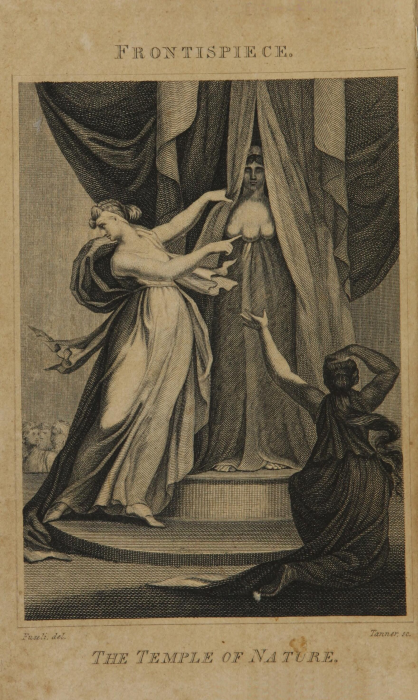
The temple of nature, or, The origin of society : a poem, with philosophical notes / by Erasmus Darwin.
IMAGE LINKED: wellcome collection, Attribution 4.0 International (CC BY 4.0)
Indeed, what is called the Secret Doctrine differs not one whit from what has been taught openly and earnestly, so far as such truth can be taught in words or pictured in symbols, by the highest minds of almost every land and language.
The difference lies less in what is taught than in the way in which it is taught; not so much in matter as in method.
Also, we must not forget that, with few exceptions, the men who have led our race farthest along the way toward the Mount of Vision, have not been men who learned their lore from any coterie of esoteric experts, but, rather, men who told in song what they had been taught in sorrow—initiates into eternal truth, to be sure, but by the grace of God and the divine right of genius!
Seers, sages, mystics, saints—these are they who, having sought in sincerity, found in reality, and the memory of them is a kind of religion.
Some of them, like Pythagoras, were trained for their quest in the schools of the Secret Doctrine, but others went their way alone, though never unattended, and, led by “the vision splendid,” they came at last to the gate and passed into the City.
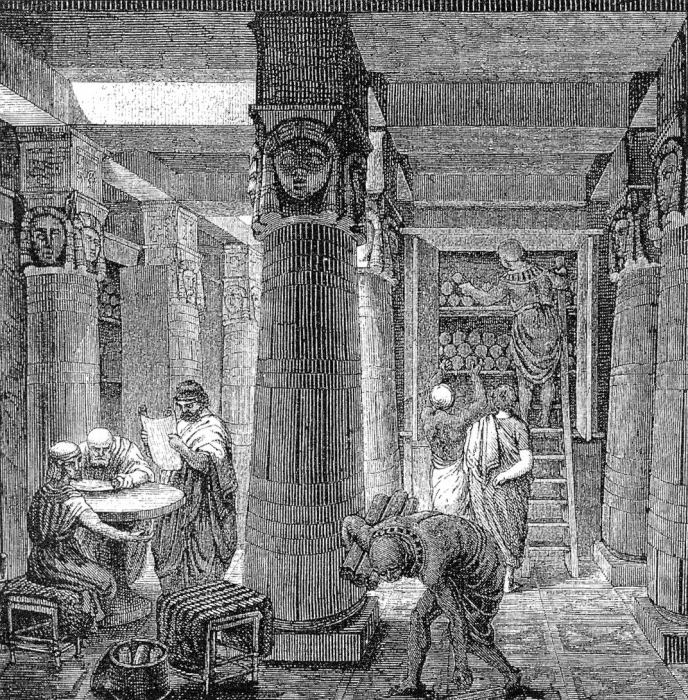
O. Von Corven’s rendering, based on some archaeological evidence, of a room in the ancient Library of Alexandria, 19th century, in The Memory of Mankind (Oak Knoll Press, 2001).
IMAGE LINKED: wikimedia Attribution 4.0 International (CC BY 4.0)
Why, then, it may be asked, speak of such a thing as the Secret Doctrine at all, since it were better named the Open Secret of the world?
For two reasons, both of which have been intimated:
first, in the olden times unwonted knowledge of any kind was a very dangerous possession, and the truths of science and philosophy, equally with religious ideas other than those in vogue among the multitude, had to seek the protection of obscurity.
If this necessity gave designing priestcraft its opportunity, it nevertheless offered the security and silence needed by the thinker and seeker after truth in dark times.
Hence there arose in the ancient world, wherever the human mind was alive and spiritual, systems of exoteric and esoteric instruction; that is, of truth taught openly and truth concealed.
Disciples were advanced from the outside to the inside of this divine philosophy, as we have seen, by degrees of initiation.
Whereas, by symbols, dark sayings, and dramatic ritual the novice received only hints of what was later made plain.
Second, this hidden teaching may indeed be described as the open secret of the world, because it is open, yet understood only by those fit to receive it.
What kept it hidden was no arbitrary restriction, but only a lack of insight and fineness of mind to appreciate and assimilate it.
Nor could it be otherwise; and this is as true today as ever it was in the days of the Mysteries, and so it will be until whatever is to be the end of mortal things.
Fitness for the finer truths cannot be conferred; it must be developed. Without it the teachings of the sages are enigmas that seem unintelligible, if not contradictory.
In so far, then, as the discipline of initiation, and its use of art in drama and symbol, help toward purity of soul and spiritual awakening, by so much do they prepare men for the truth; by so much and no further.
So that, the Secret Doctrine, whether as taught by the ancient Mysteries or by modern Masonry, is less a doctrine than a discipline; a method of organized spiritual culture, and as such has a place and a ministry among men.
II
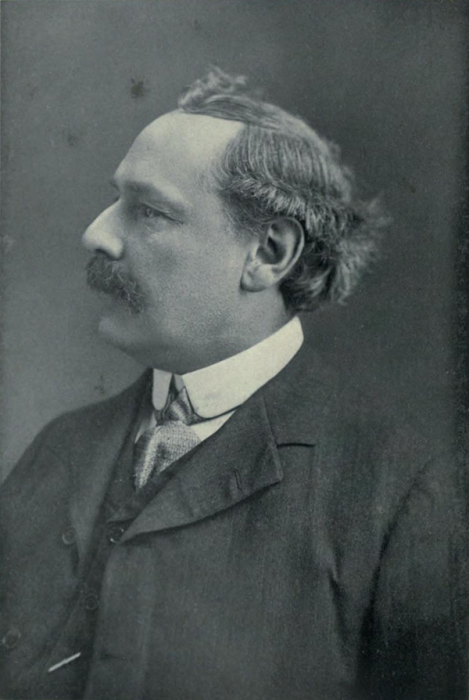
Arthur Edward Waite
IMAGE LINKED: wikimedia Attribution 4.0 International (CC BY 4.0)
Perhaps the greatest student in this field of esoteric teaching and method, certainly the greatest now living, is Arthur Edward Waite, (1857 – 1942) to whom it is a pleasure to pay tribute.
By nature a symbolist, if not a sacramentalist, he found in such studies a task for which he was almost ideally fitted by temperament, training, and genius.
Engaged in business, but not absorbed by it, years of quiet, leisurely toil have made him master of the vast literature and lore of his subject, to the study of which he brought a religious nature, the accuracy and skill of a scholar, a sureness and delicacy of insight at once sympathetic and critical, the soul of a poet, and a patience as untiring as it is rewarding; qualities rare indeed, and still more rarely blended.
Prolific but seldom prolix, he writes with grace, ease, and lucidity, albeit in a style often opulent, and touched at times with lights and jewels from old alchemists, antique liturgies, remote and haunting romance, secret orders of initiation, and other recondite sources not easily traced.
Much learning and many kinds of wisdom are in his pages, and withal an air of serenity, of tolerance; and if he is of those who turn down another street when miracles are performed in the neighborhood, it is because, having found the inner truth, he asks for no sign.
Always he writes in the conviction that all great subjects bring us back to the one subject which is alone great, and that scholarly criticisms, folk-lore, and deep philosophy are little less than useless if they fall short of directing us to our true end—the attainment of that living Truth which is about us everywhere.
He conceives of our mortal life as one eternal Quest of that living Truth, taking many phases and forms, yet ever at heart the same aspiration, to trace which he has made it his labor and joy to essay.
Through all his pages he is following out the tradition of this Quest, in its myriad aspects, especially since the Christian era, disfigured though it has been at times by superstition, and distorted at others by bigotry, but still, in what guise soever, containing as its secret the meaning of the life of man from his birth to his reunion with God who is his Goal.
And the result is a series of volumes noble in form, united in aim, unique in wealth of revealing beauty, and of unequalled worth.
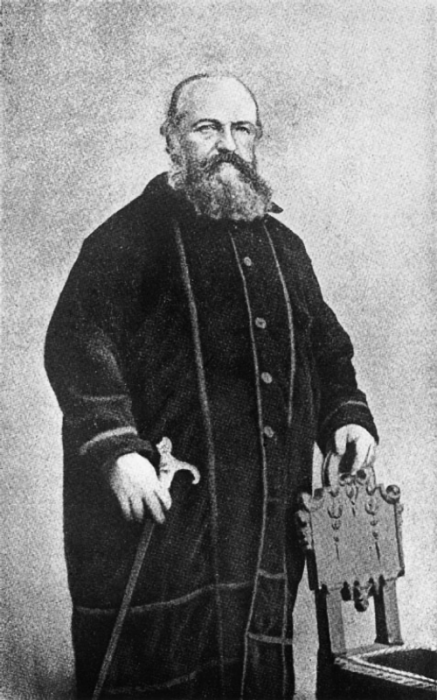
Éliphas Lévi (Alphonse Louis Constant 1810 – 1875)
IMAGE LINKED: wikimedia Attribution 4.0 International (CC BY 4.0)
Beginning as far back as 1886, Waite issued his study of the Mysteries of Magic, a digest of the writings of Eliphas Levi, to whom Albert Pike was more indebted than he let us know.
Then followed the Real History of the Rosicrucians, which traces, as far as any mortal may trace, the thread of fact whereon is strung the romance of a fraternity the very existence of which has been doubted and denied by turns.
Like all his work, it bears the impress of knowledge from the actual sources, betraying his extraordinary learning and his exceptional experience in this kind of inquiry.
Of the Quest in its distinctively Christian aspect, he has written in The Hidden Church of the Holy Graal; a work of rare beauty, of bewildering richness, written in a style which, partaking of the quality of the story told, is not at all after the manner of these days.
But the Graal Legend is only one aspect of the old-world sacred Quest, uniting the symbols of chivalry with Christian faith.
Masonry is another; and no one may ever hope to write of The Secret Tradition in Masonry with more insight and charm, or a touch more sure and revealing, than this gracious student for whom Masonry perpetuates the instituted Mysteries of antiquity, with much else derived from innumerable store-houses of treasure.
His last work is a survey of The Secret Doctrine in Israel, being a study of the Zohar, or Hebrew Book of Splendor, a feat for which no Hebrew scholar has had the heart.
This Bible of Kabbalism is indeed so confused and confusing that only a “golden dustman” would have had the patience to sift out its gems from the mountain of dross, and attempt to reduce its wide-weltering chaos to order.
Even Waite, with all his gift of research and narration, finds little more than gleams of dawn in a dim forest, brilliant vapors, and glints that tell by their very perversity and strangeness.
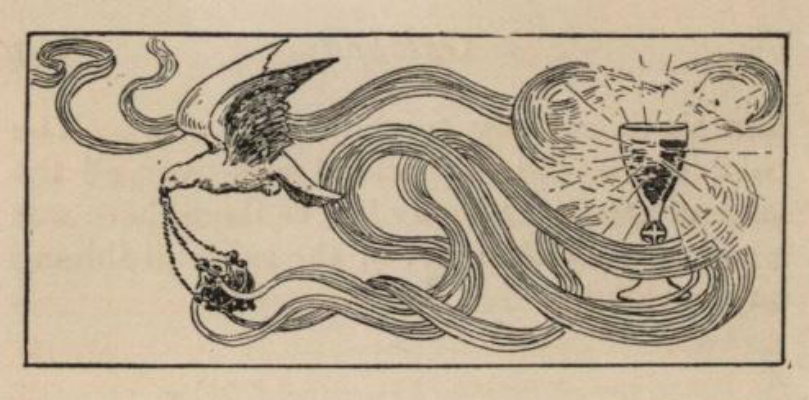
The Grail from The Knights of the Round Table: Stories of King Arthur and the Holy Grail, William Henry Frost.
IMAGE LINKED: wikimedia Attribution 4.0 International (CC BY 4.0)
Whether this age-old legend of the Quest be woven about the Cup of Christ, a Lost Word, or a design left unfinished by the death of a Master Builder, it has always these things in common:
first, the memorials of a great loss which has befallen humanity by sin, making our race a pilgrim host ever in search;
second, the intimation that what was lost still exists somewhere in time and the world, although deeply buried;
third, the faith that it will ultimately be found and the vanished glory restored;
fourth, the substitution of something temporary and less than the best, albeit never in a way to adjourn the quest;
fifth, and more rarely, the felt presence of that which was lost under veils close to the hands of all.
What though it take many forms, from the pathetic pilgrimage of the Wandering Jew to the journey to fairyland in quest of The Blue Bird, it is ever and always the same.
These are but so many symbols of the fact that men are made of one blood and born to one need; that they should seek the Lord, if haply they might feel after Him, and find Him, though He is not far from every one of us; for in Him we live and move and have our being.
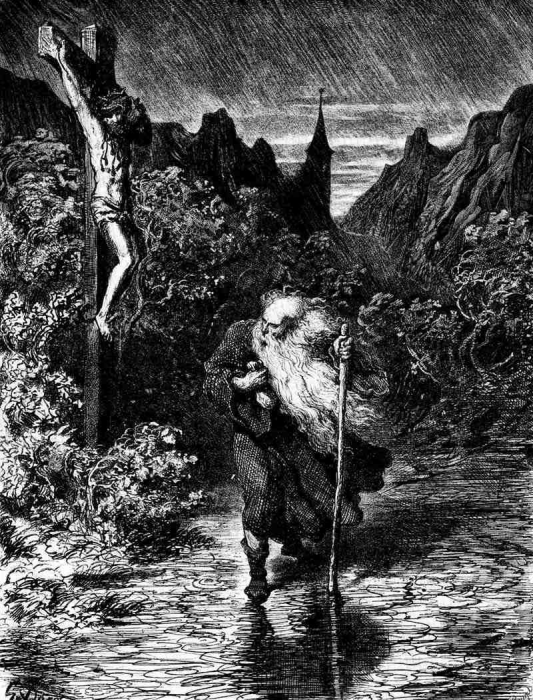
The Wandering Jew, Gustave Doré.
IMAGE LINKED: wikimedia Attribution 4.0 International (CC BY 4.0)
What, then, is the Secret Doctrine, of which this seer-like scholar has written with so many improvisations of eloquence and emphasis, and of which each of us is in quest?
What, indeed, but that which all the world is seeking—knowledge of Him whom to know aright is the fulfillment of every human need: the kinship of the soul with God; the life of purity, honor, and piety demanded by that high heredity; the unity and fellowship of the race in duty and destiny; and the faith that the soul is deathless as God its Father is deathless!
Now to accept this faith as a mere philosophy is one thing, but to realize it as an experience of the innermost heart is another and a deeper thing.
No man knows the Secret Doctrine until it has become the secret of his soul, the reigning reality of his thought, the inspiration of his acts, the form and color and glory of his life.
Happily, owing to the growth of the race in spiritual intelligence and power, the highest truth is no longer held as a sacred secret. Still, if art has efficacy to surprise and reveal the elusive Spirit of Truth, when truth is dramatically presented it is made vivid and impressive, strengthening the faith of the strongest and bringing a ray of heavenly light to many a baffled seeker.
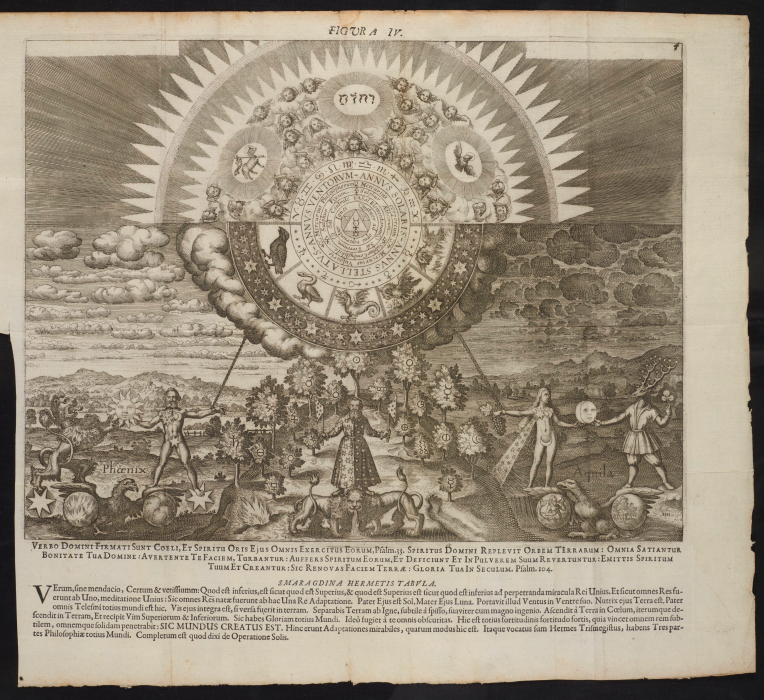
Philaletha, Basilius Valentinus, Thomas Norton, John Cremer, N. Flamel, Michael Maier, M. Sendivogius, Lambspring, de Meung, Jean, and Helvetius. Musaeum Hermeticum Reformatum Et Amplificatum. Frankfurt am Main, Germany: Apud Hermannum a Sande, 1678.
IMAGE LINKED: digital.sciencehistory.org Attribution 4.0 International (CC BY 4.0)
Ever the Quest goes on, though it is permitted some of us to believe that the Lost Word has been found, in the only way in which it can ever be found—even in the life of Him who was “the Word made flesh,” who dwelt among us and whose grace and beauty we know.
Of this Quest Masonry is an aspect, continuing the high tradition of humanity, asking men to unite in the search for the thing most worth finding, that each may share the faith of all.
Apart from its rites, there is no mystery in Masonry, save the mystery of all great and simple things.
So far from being hidden or occult, its glory lies in its openness, and its emphasis upon the realities which are to the human world what light and air are to nature.
Its mystery is of so great a kind that it is easily overlooked; its secret almost too simple to be found out.
Article by: Joseph Fort Newton
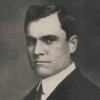
Rev. Newton (1880–1950) , was an American Baptist minister, authored a number of masonic books, including his best-known works, The Builders, published in 1914, and The Men’s House, published in 1923.
He received the third degree of Freemasonry on May 28, 1902 in Friendship Lodge No. 7, Dixon, Illinois, later affiliating with Mt. Hermon Lodge No. 263, Cedar Rapids, Iowa.
He also served as Grand Chaplain of the Grand Lodge of Iowa from 1911 to 1913 and Grand Prelate of the Grand Encampment of Knights Templar.
The Builders has been called "an outstanding classic in Masonic literature offering the early history of Freemasonry."

The Secret Doctrine: The Synthesis of Science, Religion, and Philosophy
By: H.P. Blavatsky
Continuously in print for over 100 years, the SD remains today the most comprehensive sourcebook of the esoteric tradition, outlining the fundamental tenets of the Secret Doctrine of the Archaic Ages.
Challenging, prophetic, and strikingly modern, it directly addresses the perennial questions: continuity of life after death, purpose of existence, good and evil, consciousness and substance, sexuality, karma, evolution, and human and planetary transformation.
Based on the ancient Stanzas of Dzyan with corroborating testimony from hundreds of sources, these volumes unfold the drama of cosmic and human evolution — from the reawakening of the gods after a Night of the Universe to the ultimate reunion of cosmos with its divine source.
Supplementary sections discuss relevant scientific issues as well as the mystery language of myths, symbols, and allegories, helping the reader decipher the often abstruse imagery of the world’s sacred literature.
This edition is a character-for-character, line-for-line reproduction of the two-volume 1888 first edition. It is set in new type which closely matches the Miller & Richard Old Style font used in the original. The Index at the end of Volume II is the version revised in 1925.

The Secret Teachings of All Ages
By: Manly P. Hall
This key to the world’s esoteric traditions unlocks some of the most fascinating and closely held secrets of myth, religion, and philosophy. Unrivaled in its beauty and completeness, it distills ancient and modern teachings of nearly 600 experts.
Compelling themes range from the riddle of the Sphinx and the tenets of Pythagorean astronomy to the symbolism of the pentagram, the significance of the Ark of the Covenant, and the design of the American flag.
Acclaimed by Publishers Weekly as “a classic reference, dizzying in its breadth,” this remarkable resource was compiled by the founder of the Philosophical Research Society. Author Manly P. Hall examines the secrets of Isis along with arcane aspects of mystic Christianity and other religions.
Fascinating surveys cover topics as diverse as Kabbalah, alchemy, cryptology, and Tarot, along with Masonry, gemology, and the identity of William Shakespeare. Sixteen pages of color plates and 100 black-and-white images by the celebrated illustrator J. Augustus Knapp illuminate this vast and indispensable encyclopedia of the occult.

The Secret Tradition in Freemasonry
By: Arthur Edward Waite
This work has been selected by scholars as being culturally important, and is part of the knowledge base of civilization as we know it. This work was reproduced from the original artifact, and remains as true to the original work as possible. Therefore, you will see the original copyright references, library stamps (as most of these works have been housed in our most important libraries around the world), and other notations in the work.
This work is in the public domain in the United States of America, and possibly other nations. Within the United States, you may freely copy and distribute this work, as no entity (individual or corporate) has a copyright on the body of the work.
As a reproduction of a historical artifact, this work may contain missing or blurred pages, poor pictures, errant marks, etc. Scholars believe, and we concur, that this work is important enough to be preserved, reproduced, and made generally available to the public. We appreciate your support of the preservation process, and thank you for being an important part of keeping this knowledge alive and relevant.
Recent Articles: Joseph Fort Newton
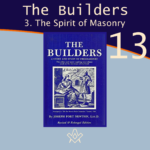 The Builders – 13 The Spirit of Masonry Chapter 13 Masonry is Friendship—friendship, first, with the great Companion, of whom our own hearts tell us, who is always nearer to us than we are to our-selves, and whose inspiration and help is the greatest fact of human experience. |
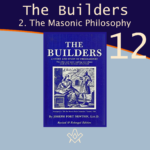 The Builders – 12 The Masonic Philosophy Chapter 12 When we look at Masonry in this large and mellow light, it is like a stately old cathedral, gray with age, rich in associations, its steps worn by innumerable feet of the living and the dead—not piteous, but strong and enduring. By Joseph Fort Newton |
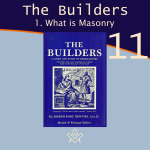 The Builders – 11 What is Masonry Chapter 11 "Masonry is the activity of closely united men who, employing symbolical forms borrowed principally from the mason's trade and from architecture, work for the welfare of mankind, striving morally to ennoble themselves and others, and thereby to bring about a universal league of mankind, which they aspire to exhibit even now on a small scale." |
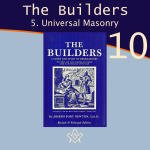 The Builders – 10 Universal Masonry Chapter 10. Universal Masonry - Henceforth, the Masons of England were no longer a society of handicraftsmen, but an association of men of all orders and every vocation, as also of almost every creed, |
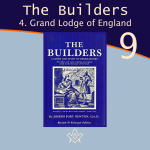 The Builders – 9 Grand Lodge of England Chapter 9. Grand Lodge of England - From every point of view, the organization of the Grand Lodge of England, in 1717, was a significant and far-reaching event. By Joseph Fort Newton |
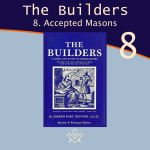 The Builders – 8 Accepted Masons Chapter 8. Accepted Masons - an examination into the history of accepted masons, and why did soldiers, scholars, antiquarians, clergymen, lawyers, and even the nobility ask to be accepted as members of the order of Free-masons? By Joseph Fort Newton |
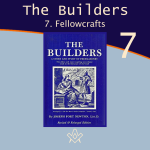 Chapter 7. the Fellowcrafts - an examination into the history of the medieval guilds, their charges and regulations that form the base for the allegories and symbols in our modern versions of masonic craft ritual. By Joseph Fort Newton |
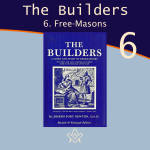 The Builders – 6 The Free-Masons Chapter 6. the Free-Masons - an examination into the history of the medieval guilds, their charges and regulations that form the base for the allegories and symbols in our modern versions of masonic craft ritual. By Joseph Fort Newton |
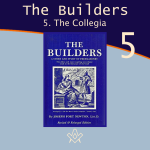 Chapter 5. The Collegia - If the laws of building were secrets known only to initiates, there must have been a secret Order of architects who built the temple of Solomon. Who were they? |
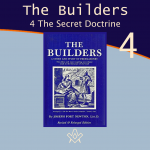 The Builders – 4 The Secret Doctrine Chapter 4. The Secret Doctrine - Explore an outstanding classic in Masonic literature - an exposition of the early history and symbolism of Freemasonry – from the foundations upwards. By Joseph Fort Newton |
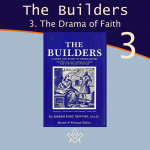 The Builders – 3 The Drama of Faith Chapter 3. The Drama of Faith - Explore an outstanding classic in Masonic literature - an exposition of the early history and symbolism of Freemasonry – from the foundations upwards. |
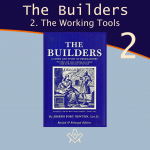 The Builders – 2 The Working Tools Chapter 3. The Working Tools - Explore an outstanding classic in Masonic literature - an exposition of the early history and symbolism of Freemasonry – from the foundations upwards. |
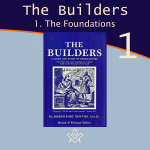 The Builders – 1 The Foundations 1. The Foundations Explore an outstanding classic in Masonic literature - an exposition of the early history and symbolism of Freemasonry – from the foundations upwards. |
masonic knowledge
to be a better citizen of the world
share the square with two brothers

click image to open email app on mobile device



